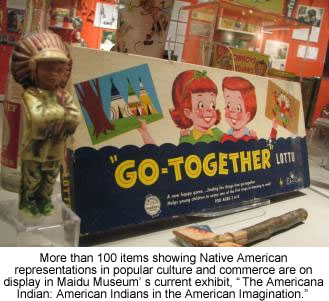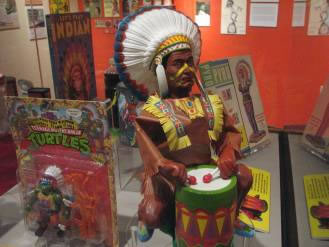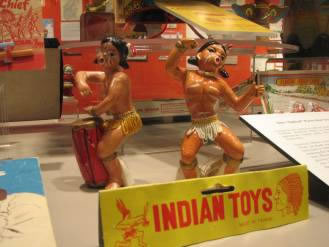 |
Canku Ota
|
 |
|
(Many Paths)
|
||
|
An Online Newsletter
Celebrating Native America
|
||
|
September 1, 2011 -
Volume 9 Number 9
|
||
|
|
||
|
‘Americana'
Shows Native American Images in Pop Culture
|
||
|
by Sena Christian -
The Roseville, CA Press Tribune
|
||
|
credits: photos courtesy
of Maidu Museum
|
 Several
"Indian head" pennants hang on display at the Maidu Museum, each with
a profile of a man wearing a feathered war bonnet. Several
"Indian head" pennants hang on display at the Maidu Museum, each with
a profile of a man wearing a feathered war bonnet.
The images, almost exactly the same, do not depict a prominent Native American in history or a person that once lived. Instead, "it's the same generic idea of an Indian that gets manufactured," and stands to represent all Indians, said Brian Baker, who curated the exhibit. "The Americana Indian: American Indians in the American Imagination" is currently on display at the Maidu Museum and Historic Site and runs through Nov. 30. Baker will give a talk during the 3rd Saturday art walk Aug. 20. Composed of seven major themes, the exhibit highlights the powerful characteristics of the Americana Indian that have been embedded into popular culture and commerce. Baker aims to show how these representations convey a narrow and singular message about Native Americans. In many ways, these fictionalized, commercial representations erase their identities and mock their cultures, he said. The collection features more than 100 items such as advertisements, board games, toys, dolls, sports paraphernalia, soda bottles, food packaging and more.
Baker has a personal interest in the topic. He is a Bad River Chippewa who grew up on a reservation in Wisconsin. He is also an associate professor of ethnic studies and American Indian studies at California State University, Sacramento. "Dealing with images and stereotypes is something I commonly focus on," Baker said. "I just started collecting objects six or seven years ago." Baker finds items at antique fairs and stores, online sites such as eBay and some have been given to him. He now has 300 pieces. One item, in the museum, is a sign with the sentence: "Indians roamed in the area for thousands of years." Baker describes "roam" as a politically and culturally charged term in the narrative of discovery that attempts to claim Native Americans didn't settle the land. A board game on display, called "Go-Together," has children match cards by identifying the correct relationship between objects — and in the process, socializes these kids, Baker said. For instance, one card shows a war-dancing, wild Indian wielding a tomahawk and wearing a feathered headdress. The card it matches? A teepee.
Advertisements for shoes, cigarettes and nail polish depict Native American squaws or princesses as highly sexualized objects. An Indian War Bonnet Kit shows people how to "play Indian." These representations reduce Native people to objects, Baker said. For instance, the exhibit notes how Ishi, the "last wild Indian," became an object of scientific study and inquiry. After dying from tuberculosis, he was decapitated and his bran removed for examination. Baker said he'll show his students a photo of a Native American in stereotypical dress and ask, "Who is this?" They answer, "An Indian." Then he'll show them a photo of a specific person, perhaps a Maidu, and repeat the question. "They are unable to identify local Native people who are their neighbors," Baker said. Supervisor Murphy hope this exhibit, as seen in the context of the museum's other exhibits, will help change that. Sena Christian can be reached at senac@goldcountrymedia.com. Follow her on Twitter at SenaC_RsvPT.
"The Americana Indian:
American Indians in the American Imagination" Where: Maidu
Museum and Historic Site, 1970 Johnson Ranch Dr. in Roseville |
|
|
||
|
|
||
| Canku Ota is a free Newsletter celebrating Native America, its traditions and accomplishments . We do not provide subscriber or visitor names to anyone. Some articles presented in Canku Ota may contain copyright material. We have received appropriate permissions for republishing any articles. Material appearing here is distributed without profit or monetary gain to those who have expressed an interest. This is in accordance with Title 17 U.S.C. Section 107. | ||
|
Canku Ota is a copyright ©
2000, 2001, 2002, 2003, 2004, 2005, 2006, 2007, 2008, 2009, 2010,
2011 of Vicki Barry and Paul Barry.
|
||
 |
 |
|
|
The "Canku
Ota - A Newsletter Celebrating Native America" web site and
its design is the
|
||
|
Copyright ©
1999, 2000, 2001, 2002, 2003, 2004, 2005,
2006, 2007, 2008, 2009, 2010, 2011
of Paul C. Barry.
|
||
|
All Rights Reserved.
|
||
 "Seeing
it all together is pretty powerful," said museum Supervisor Mark
Murphy. "As a culture, we have represented Native Americans in such
a way that's not as flattering as it could be. It's important to
recognize that."
"Seeing
it all together is pretty powerful," said museum Supervisor Mark
Murphy. "As a culture, we have represented Native Americans in such
a way that's not as flattering as it could be. It's important to
recognize that." "The
Indian is not associated with a bathtub, a school, a worksite,"
Baker said.
"The
Indian is not associated with a bathtub, a school, a worksite,"
Baker said.